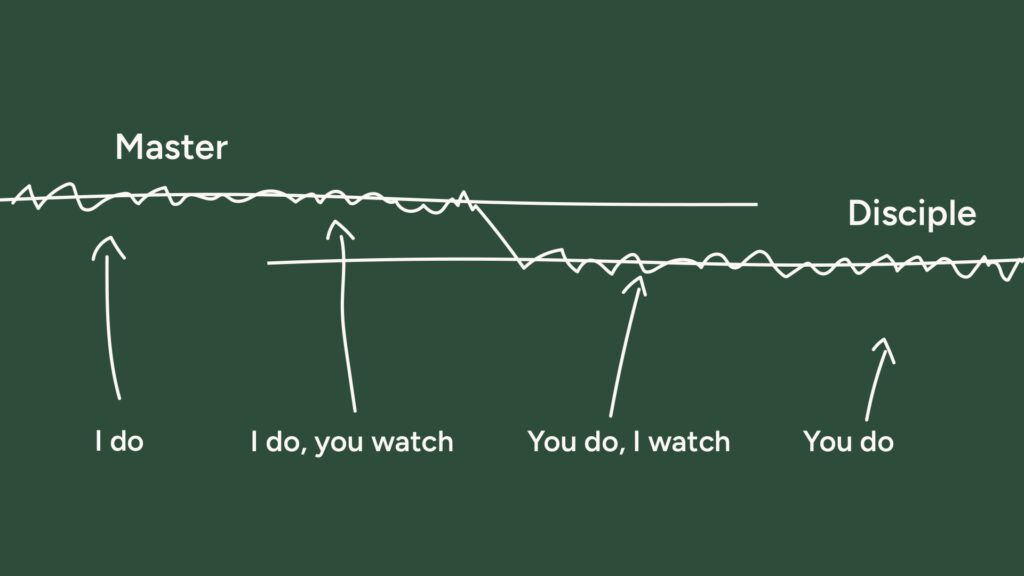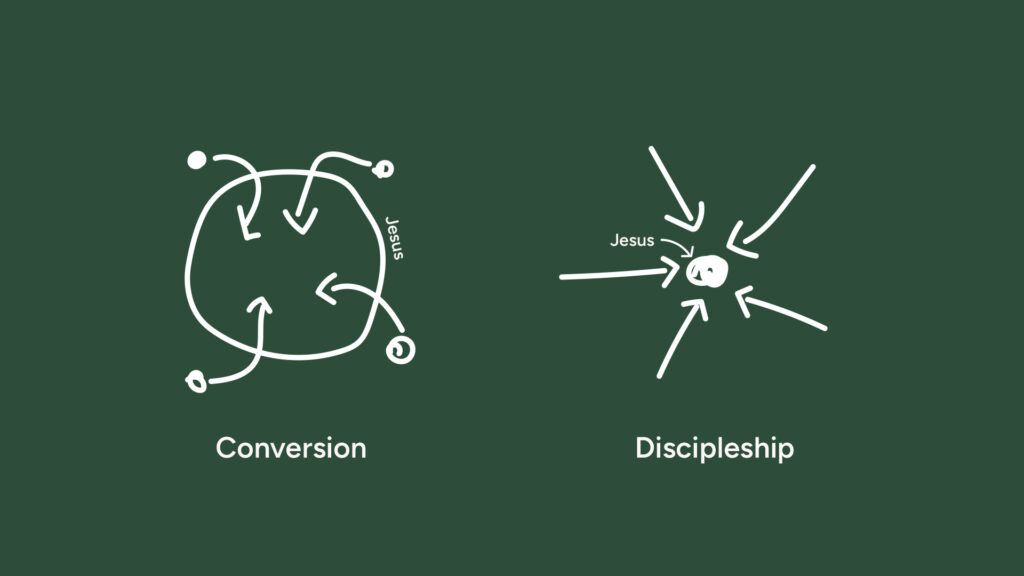A couple of weeks back, we spoke about our vision for Toowoomba Vineyard Church. It was less about numbers, programs, and buildings (though there was a little bit of that). Rather, the focus was on our framework for what the church should be doing on its best day. Spoiler alert — our primary activity is not running services. Instead, we should be making ourselves busy (note the deliberate irony in that word) with four things: worship, discipleship, mission, and community.

We like to avoid anything that resembles indoctrination at TVC. Our preference is to focus on teaching about the way of Jesus and how to think openly about what he said and did. However, if you’re a part of the church and want to understand what you haven’t formally signed up for, it’d be helpful to learn these four concepts. The purpose of this blog series is to take a deep dive into each. You can find links to the other articles at the bottom. In the meantime, let’s talk about…
Discipleship (a.k.a. apprenticeship)
In understanding the purpose of the church, one of the key scriptures comes from Matthew 28. Jesus died, rose again, appeared to many people, and just before he ascended to heaven, he said:
“All authority in heaven and on earth has been given to me. Therefore go and make disciples of all nations, baptizing them in the name of the Father and of the Son and of the Holy Spirit, and teaching them to obey everything I have commanded you. And surely I am with you always, to the very end of the age.”
— Matthew 28:18b-20
There’s so, so much to unpack in this passage, but the word couplet that sums it all up is ‘make disciples’. Everything else hangs on this.
So what exactly is a disciple, and how does one go about ‘making’ one? It’s not a word we tend to use. However, it was a well-understood paradigm in Jesus’ day. Wandering Jewish rabbis would often have a group of students (‘disciples’) follow them to learn from their teaching and practice. As a rabbi, Jesus loosely used this model, though with a few key differences:
He called them. Usually, a disciple would choose their rabbi, but (for the most part) Jesus chose his. Jesus also chose a very strange blend of followers—fishermen, tax collectors, and religious zealots—just to name a few.
They watched him. The disciples followed Jesus wherever he went. They observed his miracles, listened to his teaching, and broke bread with him. They had the opportunity to go deeper with Jesus than the crowds (see Matthew 13:1-18, for example).
They had a go themselves. On at least two occasions (see Luke 9:1-6 and Luke 10:1-24), Jesus sent his followers out to have a go at kingdom ministry for themselves. We see evidence of Jesus providing feedback, especially in Luke 10.
He released them. Finally, as we have read, Jesus commissioned his disciples to go out and make disciples of all nations.
When we boil it down to the bare minimum, a simple model emerges:

While rabbis, disciples, and the context of Second-Temple Judaism might be quite unfamiliar to us, we do have a modern equivalent that works as a neat analogy. Can you pick it? It’s apprenticeship. The way tradespeople are trained in our modern age closely mimics the discipleship model handed to us by Jesus.
Finally, but importantly, discipleship is a multiplicative activity. It’s baked into the definition — disciples make disciples, who make disciples, and so on.
Disciples or converts?
At this stage, the conversation might seem a bit theoretical. We don’t have wandering rabbis in Toowoomba in 2024, so in what way does this shape our practice? It turns out, quite a lot.
See, for a long time, the default method of growing Christianity has been preaching for conversion. We assume that if we present the gospel convincingly enough, people will fall on their knees and become believers. If they stay around church long enough, they’ll learn our language, in-jokes, and finally stop seeing their non-Christian friends.
The problem is, we don’t see Jesus doing this. He went around teaching about the kingdom. People joined him along the way, curious to learn more. At some point, some of them ‘converted’ (I would argue Peter’s confession of Christ is a ‘conversion’ moment of sorts, but that’s a whole other discussion). Jesus didn’t focus on getting people across a hypothetical line. He invited people on a journey of learning to walk in his way.
And that changes everything.
When we’re focused on converting people, we create an artificial ‘in’ and ‘out’ crowd. Those outside the church become the ‘other’. They’re wrong, and we’re right. There’s no vision for their lives except to join our church and take up some empty seats.

When we think about making disciples, we have a vision for every person to discover the wholeness of life and the uniqueness of their call in Christ. We recognize the image of God in every person and see potential for them to play a role in the kingdom. The journey doesn’t end at conversion. In some ways, it never ends — it’s a lifelong process of being formed into Jesus’ likeness.
Let’s be clear. We want to see people come into a saving relationship with Jesus. We value evangelism and preaching of the word. But we want to do it Jesus’ way.
There’s so much more we could say about this, but let’s get super practical.
Translating it into vision
So how do we want this to tangibly shape what we’re doing at TVC? There are at least three things we want to pursue in the next three to five years.
A commitment to formation
As a Vineyard church, we earnestly seek the work of the Holy Spirit today. We usually associate this with signs, wonders, and miracles. We will continue to pursue these. But it’s easy to forget that when the Spirit comes, he also brings profound transformation in our lives. As a church, we want to put practices in place that help us become mature disciples of Jesus.
A posture of humility
When we remember we are disciples of Jesus, it changes our attitude. We can adopt a ‘growth mindset’, remembering that we always have more to learn. Unfortunately, churches often take the position that they have all the answers. We want to have a different posture: one of humility.
A context for leadership development
We love being a small, intimate church group. However, our plan is not to stay small forever. As a church plant, we want to grow to the point where we can release other churches. The key activity in this pursuit is discipling new planters and leaders. Size isn’t everything when it comes to church planting, but by increasing in size we can create more opportunities for upcoming leaders to have a go.
—
Do you have thoughts? Feel free to drop them in the comments below. If you’d like to follow along with this blog series, you can subscribe to our ‘almost weekly’ email here.
—
This post is part of a four-part series on our vision and mission. You can find the other posts here:
Leave a Reply